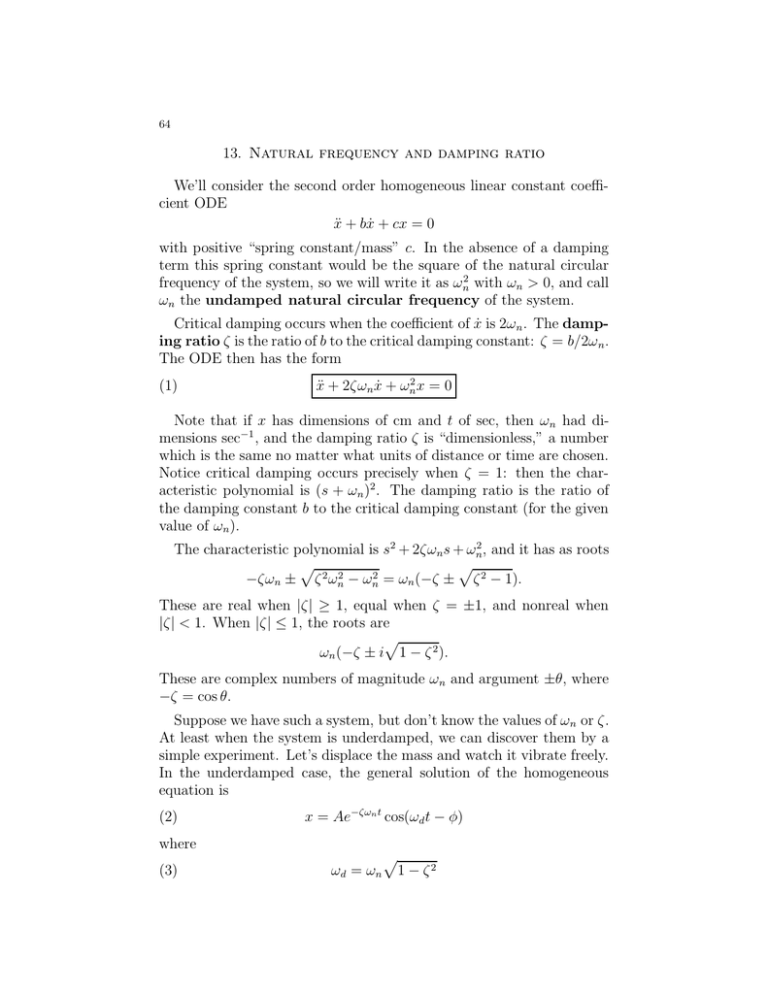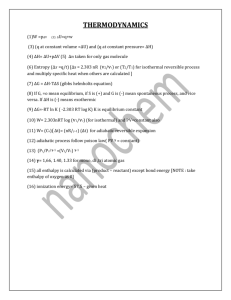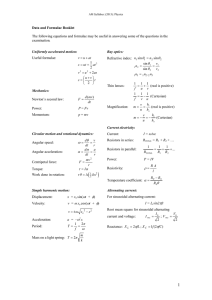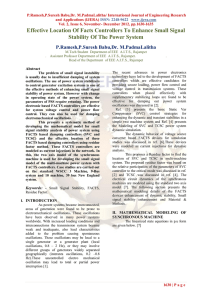Natural frequency and damping
advertisement

64 13. Natural frequency and damping ratio We’ll consider the second order homogeneous linear constant coeffi­ cient ODE ẍ + bẋ + cx = 0 with positive “spring constant/mass” c. In the absence of a damping term this spring constant would be the square of the natural circular frequency of the system, so we will write it as �n2 with �n > 0, and call �n the undamped natural circular frequency of the system. Critical damping occurs when the coefficient of ẋ is 2�n . The damp­ ing ratio α is the ratio of b to the critical damping constant: α = b/2�n . The ODE then has the form (1) x¨ + 2α�n ẋ + �n2 x = 0 Note that if x has dimensions of cm and t of sec, then �n had di­ mensions sec−1 , and the damping ratio α is “dimensionless,” a number which is the same no matter what units of distance or time are chosen. Notice critical damping occurs precisely when α = 1: then the char­ acteristic polynomial is (s + �n )2 . The damping ratio is the ratio of the damping constant b to the critical damping constant (for the given value of �n ). The characteristic polynomial is s2 + 2α�ns + �n2 , and it has as roots � � −α�n ± α 2 �n2 − �n2 = �n (−α ± α 2 − 1). These are real when |α | ∗ 1, equal when α = ±1, and nonreal when |α | < 1. When |α | → 1, the roots are � �n (−α ± i 1 − α 2 ). These are complex numbers of magnitude �n and argument ±ζ, where −α = cos ζ. Suppose we have such a system, but don’t know the values of �n or α. At least when the system is underdamped, we can discover them by a simple experiment. Let’s displace the mass and watch it vibrate freely. In the underdamped case, the general solution of the homogeneous equation is (2) x = Ae−λ�n t cos(�d t − π) where (3) � d = �n � 1 − α2 65 is the damped natural frequency of the system. Notice the effect of damping on the natural frequency! It decreases from its undamped � value by a factor of 1 − α 2 . Let’s study the times at which x achieves its maxima. These occur when the derivative vanishes, and ẋ = Ae−λ�n t (−α�n cos(�d t − π) − �d sin(�d t − π)) . The second factor is sinusoidal with circular frequency �d , so successive zeros are separated from each other by a time lapse of ν/�d . If t1 and t2 are the times of neighboring maxima of x (which occur at every other extremum) then t2 − t1 = 2ν/�d , or 2ν (4) �d = . t2 − t 1 We can also measure the ratio of the value of x at two successive maxima. Write x1 = x(t1 ) and x2 = x(t2 ). The difference of their natural logarithms is the logarithmic decrement: � � x1 � = ln x1 − ln x2 = ln . x2 Then x2 = e−� x1 . Also, x attains a local minimum halfway between t1 and t2 , and � � t1 + t 2 = −e−�/2 x(t1 ). x 2 The logarithmic decrement turns out to depend only on the damping ratio. To see this, note that the values of cos(�d t − π) at two points of time differing by 2ν/�d are equal. Using (2) we find x1 e−λ�n t1 = −λ�n t2 = eλ�n (t2 −t1 ) . x2 e Thus, using (4) and (3), � � 2ν 2να x1 � = ln = α�n(t2 − t1 ) = α�n =� . x2 �d 1 − α2 From the quantities �d and �, which are directly measurable charac­ teristics of the unforced system response, we can calculate the system parameters �n and α: � � �2 �d �/2ν � , �n = � = 1+ �d . (5) α = � 2 2 2ν 1 + (�/2ν) 1−α



